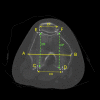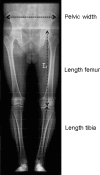The John Insall Award: Both morphotype and gender influence the shape of the knee in patients undergoing TKA
- PMID: 19669385
- PMCID: PMC2795809
- DOI: 10.1007/s11999-009-1016-2
The John Insall Award: Both morphotype and gender influence the shape of the knee in patients undergoing TKA
Abstract
There is an ongoing debate whether gender differences in the dimensions of the knee should influence the design of TKA components. We hypothesized that not only gender but also the patient's morphotype determined the shape of the distal femur and proximal tibia and that this factor should be taken into account when designing gender-specific TKA implants. We reviewed all 1000 European white patients undergoing TKA between April 2003 and June 2007 and stratified each into one of three groups based on their anatomic constitution: endomorph, ectomorph, or mesomorph. Of the 250 smallest knees, 98% were female, whereas 81% of the 250 largest knees were male. In the group with intermediate-sized knees, female knees were narrower than male knees. Patients with smaller knees (predominantly female) demonstrated large variability between narrow and wide mediolateral dimensions irrespective of gender. The same was true for larger knees (predominantly male). This variability within gender could partially be explained by morphotypic variation. Patients with short and wide morphotype (endomorph) had, irrespective of gender, wider knees, whereas patients with long and narrow morphotype (ectomorph) had narrower knees. The shape of the knee is therefore not only dependent on gender, but also on the morphotype of the patient.
Level of evidence: Level I, diagnostic study. See Guidelines for Authors for a complete description of levels of evidence.
Figures







References
-
- Barrett WP. The need for gender-specific prostheses in TKA: does size make a difference? Orthopedics. 2006;29:S53–S55. - PubMed
-
- Bulbulian R. The influence of somatotype on anthropometric prediction of body composition in young women. Med Sci Sports Exerc. 1984;16:389–397. - PubMed
-
- Charlton WP, St John TA, Ciccotti MG, Harrison N, Schweitzer M. Differences in femoral notch anatomy between men and women: a magnetic resonance imaging study. Am J Sports Med. 2002;30:329–333. - PubMed
MeSH terms
LinkOut - more resources
Full Text Sources
Medical
Research Materials
Miscellaneous

